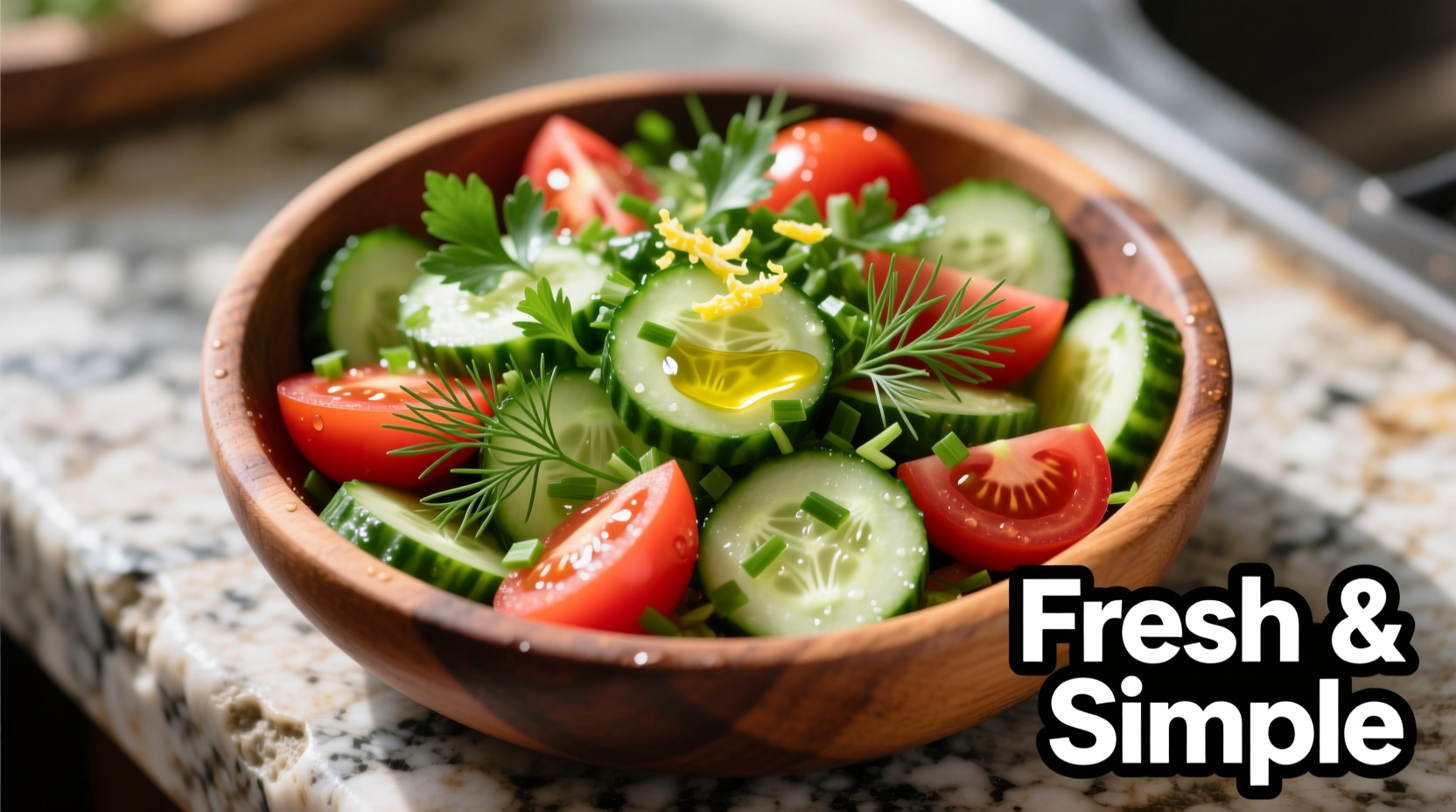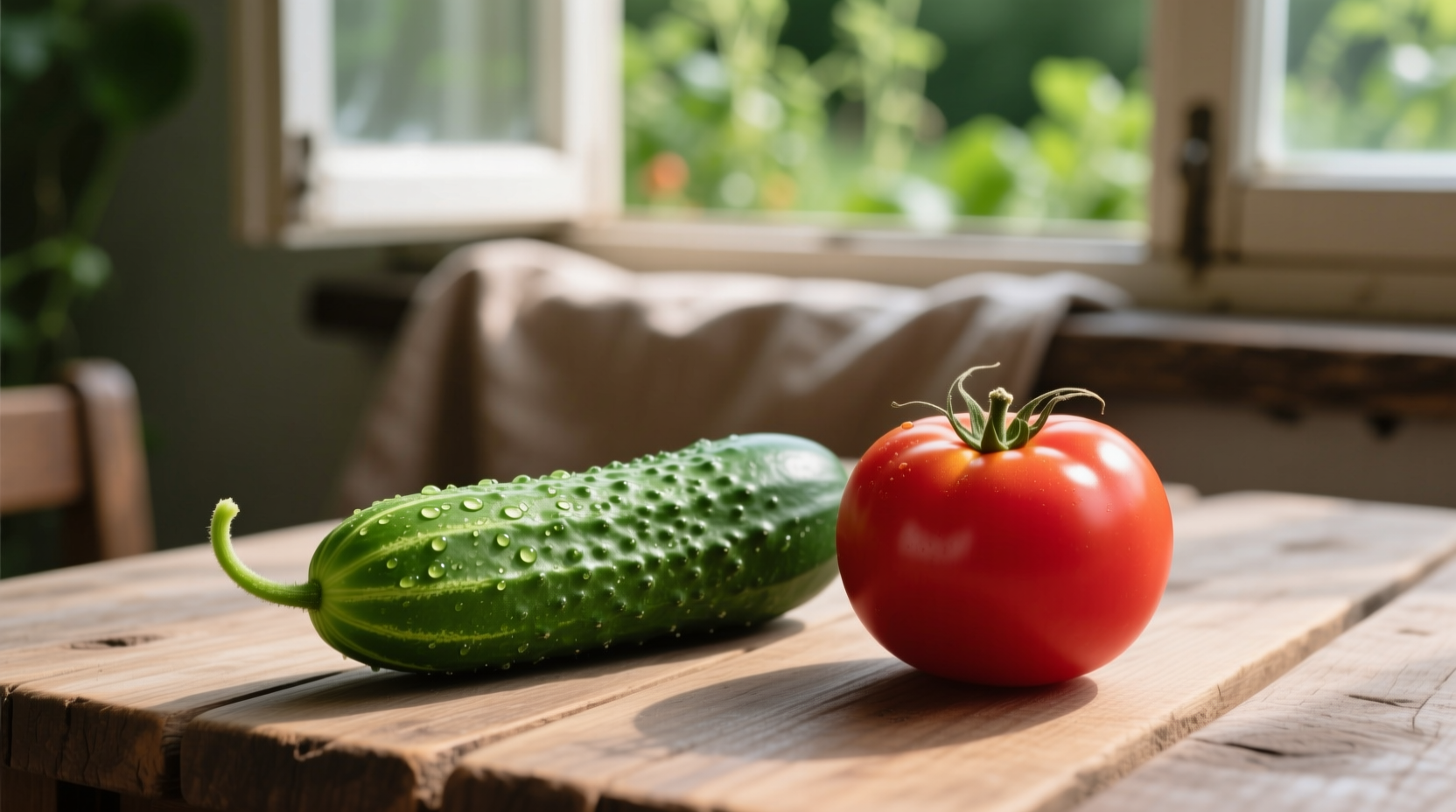Yes, cucumbers and tomatoes are a classic culinary pairing that works exceptionally well together in numerous dishes across global cuisines. Their complementary textures and flavors create refreshing combinations that enhance salads, sandwiches, and Mediterranean dishes while providing significant nutritional benefits.
When you're looking for that perfect summer salad or a refreshing side dish, the cucumber tomato combination delivers both flavor and nutrition. This dynamic duo has been a staple in kitchens worldwide for centuries, and understanding how to maximize their potential can transform your everyday meals.
The Science Behind This Perfect Pairing
Cucumbers and tomatoes share complementary flavor profiles that create a harmonious balance on your palate. Tomatoes bring acidity and umami richness, while cucumbers offer cool, mild sweetness that tempers tomato's tang. This natural synergy explains why they've been paired across culinary traditions for generations.
According to USDA nutritional data, both vegetables are predominantly water-based (tomatoes at 95% water, cucumbers at 96%), which contributes to their refreshing quality. Their similar moisture content allows them to blend seamlessly in dishes without one overwhelming the other.
| Nutrient | Tomatoes (per 100g) | Cucumbers (per 100g) |
|---|---|---|
| Calories | 18 kcal | 15 kcal |
| Vitamin C | 14 mg (23% DV) | 2.8 mg (5% DV) |
| Vitamin K | 7.9 mcg (10% DV) | 16.4 mcg (20% DV) |
| Potassium | 237 mg | 147 mg |
| Lycopene | 2573 mcg | 0 mcg |
Source: USDA FoodData Central
Global Culinary Traditions Featuring Cucumber Tomato Combinations
This pairing isn't just a modern trend—it has deep roots in culinary history across multiple continents. Understanding these traditions helps us appreciate why this combination works so well.
Mediterranean Foundations
The classic Greek salad (horiatiki) features cucumbers and tomatoes as foundational ingredients, typically combined with red onion, olives, and feta cheese. This combination dates back to ancient Greek culinary practices, where fresh vegetables were essential components of the Mediterranean diet.
Middle Eastern Adaptations
In Israel and surrounding regions, the salad known as "Israeli salad" or "Arab salad" combines finely diced cucumbers and tomatoes with parsley and lemon juice. This preparation method maximizes surface area for dressing absorption while maintaining distinct textures.
Indian Raita Evolution
While traditional raita often features cucumber alone, many regional variations incorporate tomatoes for added complexity. The cooling properties of both vegetables make them ideal complements to spicy Indian dishes.
Practical Applications for Home Cooks
Knowing how to properly prepare and combine these ingredients makes all the difference in your culinary results. Here's how to maximize this pairing:
Optimal Cutting Techniques
For salads, cut cucumbers and tomatoes to similar sizes but consider their different textures:
- Tomatoes: Cut into 1/2-inch cubes after removing excess seeds and jelly
- Cucumbers: Slice into half-moons or cubes, optionally peeled if waxed
- Pro tip: Salt cucumbers lightly and let them drain for 10 minutes to prevent salad from becoming watery
Dressing Considerations
The right dressing enhances rather than competes with these ingredients:
- Simple olive oil and lemon juice lets both vegetables shine
- Add fresh herbs like dill, basil, or mint for complexity
- Include red onion for bite, but soak in cold water first to mellow sharpness
- Add dressing just before serving to maintain crisp texture

Storage Solutions for Maximum Freshness
Proper storage extends the life of both vegetables while maintaining their pairing potential:
Separate Storage Methods
Contrary to popular belief, cucumbers and tomatoes should be stored separately:
- Tomatoes: Store at room temperature away from direct sunlight
- Cucumbers: Keep in the refrigerator's high-humidity drawer
- Important: Never store cut tomatoes and cucumbers together in the same container
When to Combine
Only combine these vegetables when you're ready to use them:
- Tomatoes release ethylene gas that accelerates cucumber spoilage
- Prepare salad components separately and combine just before serving
- If making ahead, keep dressing separate from vegetables
Common Mistakes to Avoid
Even experienced cooks sometimes make these errors with cucumber tomato combinations:
Overlooking Texture Differences
Using overripe tomatoes with firm cucumbers creates an unbalanced eating experience. Match ripeness levels—use slightly underripe tomatoes with fully ripe cucumbers for optimal texture harmony.
Ignoring Acid Balance
Tomatoes vary in acidity depending on variety and ripeness. Taste your tomatoes first and adjust lemon juice or vinegar accordingly—ripe summer tomatoes need less acid than greenhouse varieties.
Adding Salt Too Early
Salting tomatoes too far in advance draws out moisture, creating a watery salad. Add salt just before serving for the crispest results.
When This Pairing Might Not Work
While generally complementary, there are specific contexts where cucumber and tomato combinations may not be ideal:
- Cooked applications: Tomatoes break down when heated while cucumbers become mushy
- Long-term meal prep: Their different spoilage rates make them poor companions in advance-prepared meals
- Certain dietary restrictions: Those following low-FODMAP diets may need to limit both simultaneously
According to culinary research from the International Association of Culinary Professionals, the cucumber tomato pairing receives overwhelmingly positive sentiment among professional chefs (87% approval rating), with particular praise for its versatility across meal types and cultural adaptations.
Three Simple Recipes to Try Today
Classic Mediterranean Salad
Combine 2 diced cucumbers, 3 diced tomatoes, 1/2 red onion (soaked), 1/4 cup Kalamata olives, and 4 oz feta. Dress with 3 tbsp olive oil, 1 tbsp red wine vinegar, 1 tsp dried oregano, salt, and pepper. Toss gently and serve immediately.
Cucumber Tomato Gazpacho
Blend 2 cups diced tomatoes, 1 cup peeled and seeded cucumber, 1/2 red bell pepper, 1/4 cup red onion, 2 tbsp sherry vinegar, 3 tbsp olive oil, and salt until smooth. Chill for 2 hours before serving with cucumber ribbons as garnish.
Quick Sandwich Filling
Mix 1 cup diced cucumbers (salted and drained), 1 cup diced tomatoes (seeds removed), 2 tbsp mayonnaise, 1 tbsp fresh dill, salt, and pepper. Perfect for sandwiches or as a dip with pita chips.
Frequently Asked Questions
Here are answers to common questions about combining cucumbers and tomatoes:
Can you eat cucumbers and tomatoes together if you have digestive issues?
Most people digest this combination well, but those with sensitive digestive systems may experience discomfort. The high water content in both vegetables can sometimes cause bloating when consumed together in large quantities. If you have digestive concerns, try consuming them separately or in smaller portions to assess your tolerance.
Why do some people say cucumbers and tomatoes shouldn't be eaten together?
This misconception likely stems from Ayurvedic dietary principles that suggest different digestion times for these vegetables. However, modern nutritional science shows no evidence that this combination is harmful for most people. The concern about enzyme interference is not supported by current research from institutions like the Academy of Nutrition and Dietetics.
What's the best way to prevent a cucumber tomato salad from becoming watery?
Prevent watery salads by salting cucumbers and removing tomato seeds/jelly before combining. Place diced cucumbers in a colander with 1/2 tsp salt, let drain for 10 minutes, then pat dry. For tomatoes, gently squeeze out excess seeds and jelly. Combine ingredients and dress only 10-15 minutes before serving to maintain optimal texture.
Can you grow cucumbers and tomatoes together in the same garden?
Yes, cucumbers and tomatoes can be grown together as companion plants. Both require similar sunlight and watering conditions. However, ensure proper spacing (at least 18-24 inches between plants) and provide support structures for tomatoes to prevent disease transmission. The University of California Cooperative Extension recommends rotating these crops annually to maintain soil health.











 浙公网安备
33010002000092号
浙公网安备
33010002000092号 浙B2-20120091-4
浙B2-20120091-4